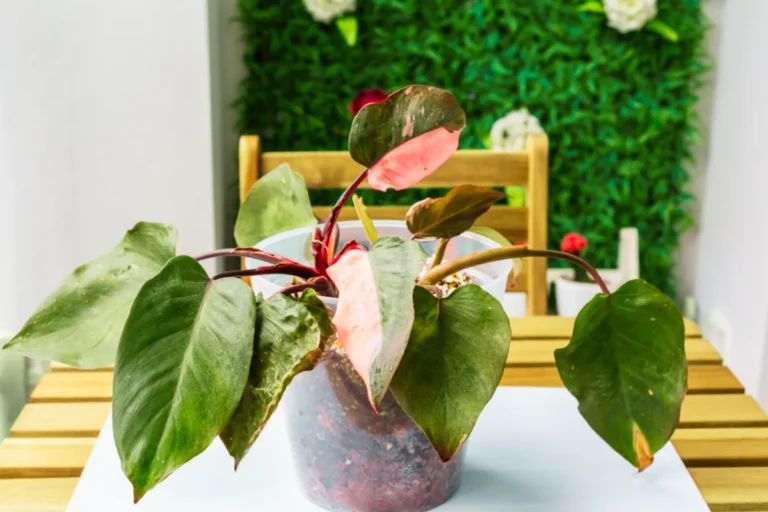Lifespan of Pink Princess Philodendron – Full Growth Journey

Do you find yourself questioning how long your Pink Princess Philodendron will live or why it’s not growing as fast as you expected? Are you struggling to keep its iconic pink variegation vibrant, or unsure about the right balance of water, light, and care? Maybe you’re worried about pests, leggy growth, or signs of aging in your plant. This blog is crafted just for you! Explore the full growth journey of the Pink Princess Philodendron and get actionable insights to overcome these common challenges, ensuring your plant thrives beautifully at every stage of its life.
Instant Answer
A Pink Princess Philodendron can live 10–20+ years with good care. Give it bright indirect light, well-draining soil, and proper watering to help it thrive long-term.
How Long Does Pink Princess Philodendron Live?
The Proper Pink Princess Philodendron care, can make it alive for several years—often 10 to 15 years or more. Its lifespan largely depends on the environment you provide and how consistently you meet its needs. Think of it as a long-term companion that grows and evolves with you.
If you’re noticing slowed growth, yellowing leaves, or fading pink, don’t panic—these are your plant’s way of telling you it needs attention. By understanding its cues and making small adjustments, you can ensure your Pink Princess remains a vibrant centerpiece in your space for years to come. Think of it as a bond that deepens with care and time. This blog is here to guide you every step of the way.
Stages of Pink Princess Philodendron Lifespan
1. Germination Stage
The germination stage, when grown from seeds, typically takes 2–4 weeks. During this time, seeds awaken under the right conditions of warmth, moisture, and light, slowly developing tiny roots and sprouting their first leaves.
Conditions for Successful Germination:
2. Seedling Stage
The seedling stage lasts about 2–3 months. During this period, the plant develops its first true leaves, with hints of its iconic pink variegation starting to appear. This stage requires consistent care as the plant builds its foundation for future growth.
Care Tips for Seedlings:
3. Vegetative Growth Stage
The vegetative growth stage spans 1–3 years, depending on the care and environment provided. This is when the Pink Princess reaches its full foliage potential, producing lush, variegated leaves and growing steadily in size.
Care Tips for Vigorous Growth:
4. Flowering Stage
Flowering is a rare occurrence indoors and only happens if the plant is fully mature, which typically takes 3–5 years. Even then, the Pink Princess Philodendron may not flower unless ideal conditions are met, and it’s often valued more for its foliage than its blooms.
Encouraging Flowering:
5. Seed Production Stage
Seed production follows flowering, but this is highly unlikely in home environments without manual pollination. The time required for seeds to mature can vary, but this stage is rarely pursued by most Pink Princess growers.
Conditions for Seed Production:
Each stage reflects the Pink Princess Philodendron’s unique growth journey, from its humble beginnings to its striking display of pink foliage and potential flowering in ideal conditions.
How to Keep Survive Pink Princess For Long Time
The longevity of your Pink Princess Philodendron depends on several key factors, each requiring your attention to ensure it thrives for years to come. By consistently meeting these needs, you can help your Pink Princess thrive and enjoy its stunning beauty for many years.
Signs of an Aging Pink Princess: What to Expect
Changes in Growth Patterns Over Time
You notice your Pink Princess is growing slower than before, with fewer new leaves. Don’t worry—this is natural as it ages and focuses on maintaining its existing growth. If you see no new growth at all, check its light and watering to ensure it’s still getting the care it needs.
Yellowing or Drooping Leaves: Aging or Stress?
You spot a few yellow leaves or drooping stems—if they’re older, it’s just the plant aging. But if new growth is affected, it could be too much water, pests, or insufficient light. Take a closer look and adjust its care accordingly.
How to Help Your Plant Thrive in Its Later Years
To keep your Pink Princess thriving, ensure it’s in a stable, bright spot with indirect light. Trim yellow leaves and repot every 1–2 years. These steps will help it continue to grow and stay healthy for years to come.
Common Issues Arise in Life of pink Princess
Variegation Loss
Slow or Stalled Growth
Yellowing or Drooping Leaves
Root Rot
Leggy Growth
Pests and Diseases
By nurturing your Pink Princess with these simple steps, you’ll help it thrive for years to come. Each issue is just a reminder that your plant needs a little more love and attention, and with your care, it’ll bounce back stronger than ever.
Signs of an Aging Pink Princess: What to Expect
Changes in Growth Patterns Over Time
You notice your Pink Princess is growing slower than before, with fewer new leaves. Don’t worry—this is natural as it ages and focuses on maintaining its existing growth. If you see no new growth at all, check its light and watering to ensure it’s still getting the care it needs.
Yellowing or Drooping Leaves: Aging or Stress?
You spot a few yellow leaves or drooping stems—if they’re older, it’s just the plant aging. But if new growth is affected, it could be too much water, pests, or insufficient light. Take a closer look and adjust its care accordingly.
How to Help Your Plant Thrive in Its Later Years
To keep your Pink Princess thriving, ensure it’s in a stable, bright spot with indirect light. Trim yellow leaves and repot every 1–2 years. These steps will help it continue to grow and stay healthy for years to come.
Final Thoughts
Caring for a Pink Princess Philodendron through its full growth journey is a rewarding experience that requires attention, patience, and knowledge. From germination to maturity, we’ve covered the essential aspects of light, water, soil, and common challenges to help your plant thrive. Whether it’s managing growth stages or addressing common issues, you now have the tools to provide the best care. We hope this guide gives you the confidence to nurture your Pink Princess for years to come. With the right care, it will flourish, and as always, we’re here to help with any future queries.






